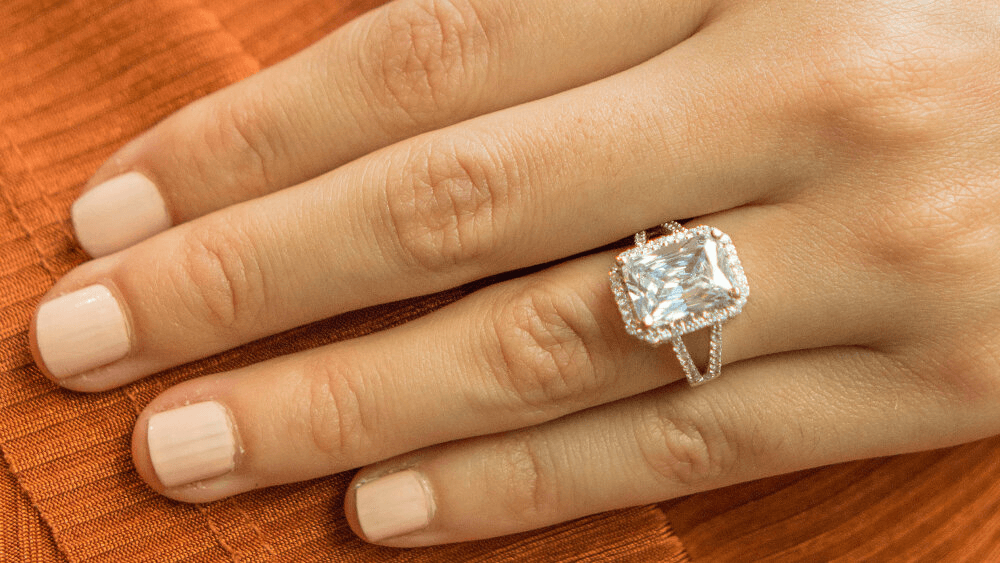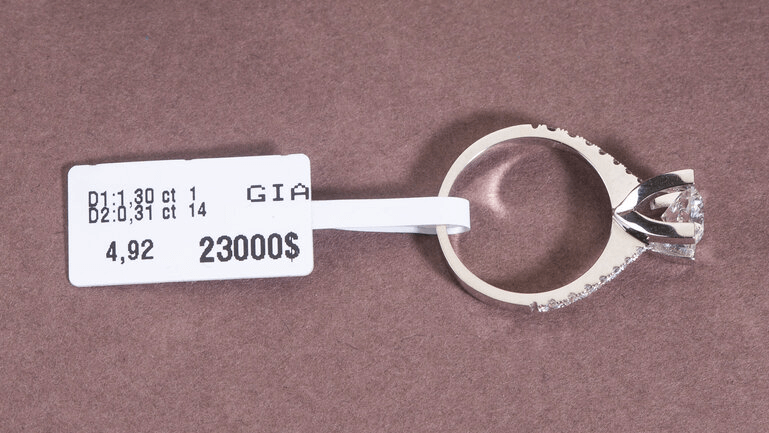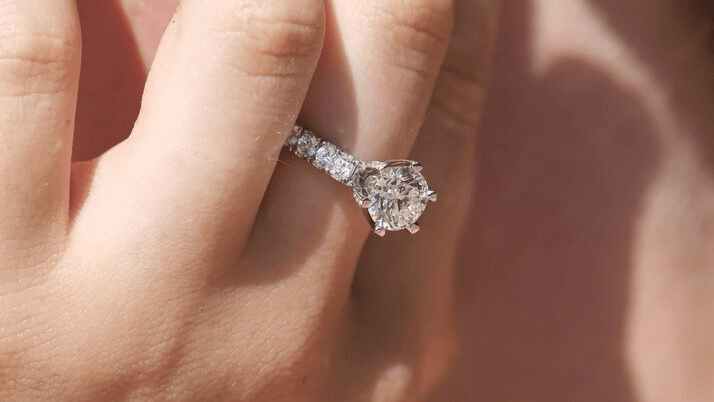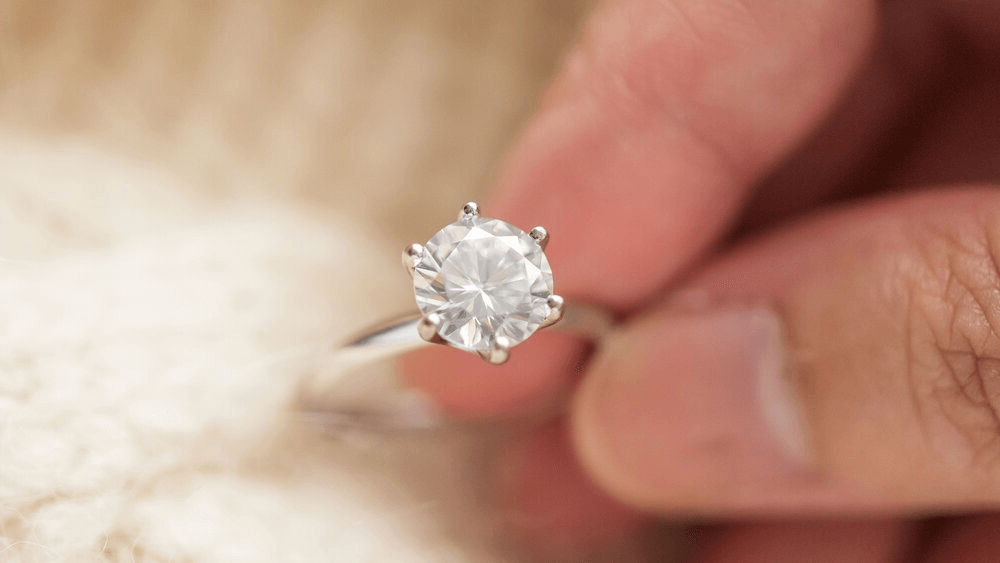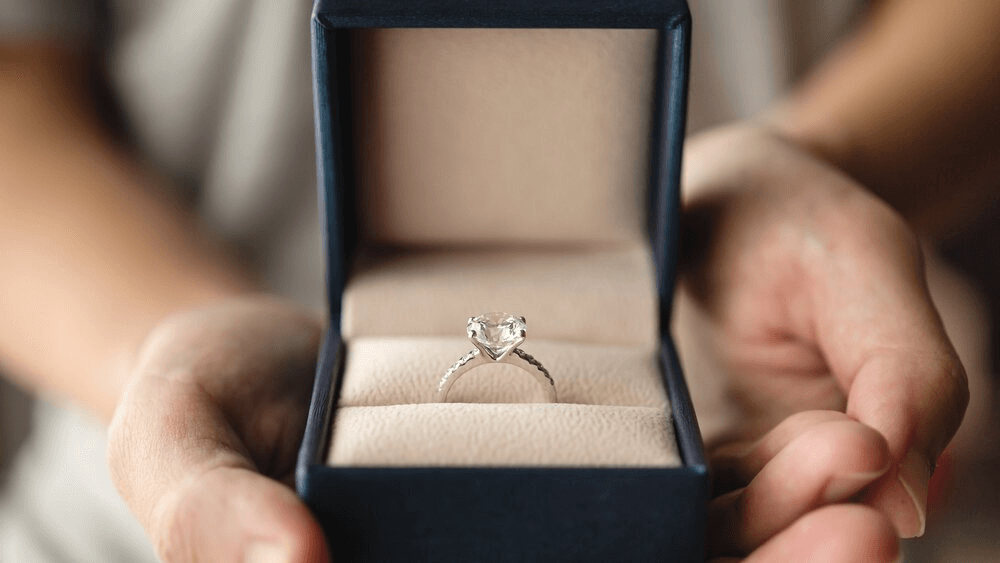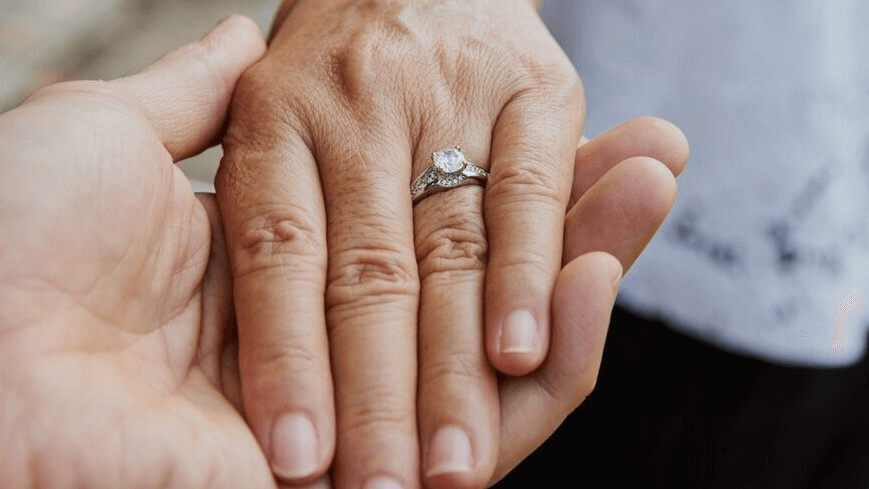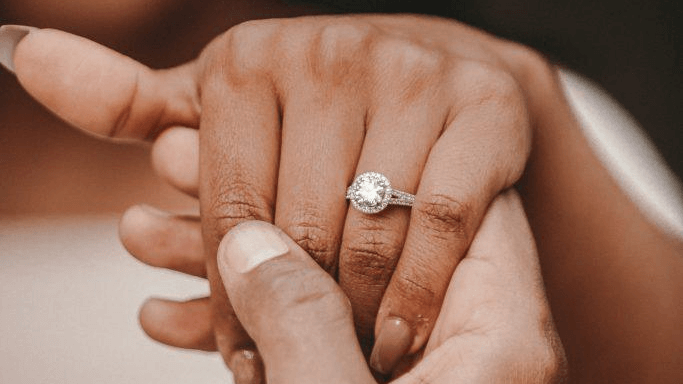The Secret Power of a $15,000 Engagement Ring

By Gary A.

Edited by Olivia H.
Published Aug 13, 2024
Edited on Mar 31, 2025
A $15,000 engagement ring isn’t just a piece of jewelry; it’s a statement of love, luxury, and commitment that can truly make your proposal unforgettable. Dive into our guide to discover what this budget can really offer.
🎧 Listen to our expert insights:

Navigate this guide:
- 7 Quick Tips for Choosing a $15,000 Engagement Ring
- Introduction
- Understanding Your Budget
- The Art of Selecting a Diamond
- Design and Craftsmanship
- The $15,000 Budget: Navigating Your Options
- Our Expert Take
- 7 Frequently Asked Questions about Budgeting $15,000 for an Engagement Ring
- Recently Purchased $15000 Engagement Rings for Inspiration
Before we dive deeper into the specifics, here are some practical tips to help guide your decision-making process:
7 Quick Tips for Choosing a $15,000 Engagement Ring
Tip 1: Certification is Key:
- Always ensure the diamond comes with a certification from a reputable lab. This confirms the diamond’s attributes and ensures you’re getting what you’re paying for. Popular labs include the Gemological Institute of America (GIA)
Tip 2: Understand Diamond Shapes:
- Beyond the classic round diamond, there are many shapes, including princess, cushion, oval, and pear. Each shape has its unique characteristics and may affect the diamond’s brilliance differently.
Tip 3: The Four Cs:
- Always start with the basics: Carat (size), Cut (quality of the cut), Clarity (amount of imperfections), and Color (how white/clear the diamond is). For a $15000 budget, it’s essential to find the right balance among these four attributes to get the best value.
Tip 4: Ring Setting Security:
- Examine how the diamond is set in the ring. Prong settings can be more vulnerable to getting caught in fabrics, while bezel or tension settings might offer better protection for the stone.
- The setting can dramatically change the ring’s overall appearance. Ensure the setting complements both the diamond and your partner’s preferences. Consider settings like solitaire, halo, pave, etc.
Tip 5: Metal Matters:
- Platinum is hypoallergenic and doesn’t tarnish but can be pricier. Gold comes in various colors and carats; 14k gold might offer durability and a more attractive price point than 18k.
Tip 6: Resale and Upgrade Policies:
- Some jewelers offer buy-back or upgrade policies, where you can trade in the ring for a more valuable one in the future. This might be worth considering if you foresee wanting to upgrade later.
Tip 7: Hidden Costs:
- Engravings, extended warranties, or ring resizing can come at extra costs. It’s essential to factor these in to avoid going over budget.
Now that you’ve got these practical tips, use Jeweler AI below to find the perfect engagement ring that suits your style and budget:
Introduction
A budget of $15,000 will take you a long way if you’re int he market for an engagement ring, but you still need to get your head around what’s within your budget – and what’s outside of it.
Understanding Your Budget
For starters, $15,000 is a generous budget. It’s more than double the nationwide average, which comes in around $6,000 on the diamond and ring combined. If you’re following our guidance of an 80/20 split between the two elements (which we’ll look at in more detail below), then that gives you a very attractive sum of $12,000 to spend on the diamond, which will give you a lot of wiggle room while you shop.
While it depends on your own preferences more than anything, $13,000 is a great amount for breaking out of the mould and choosing something a little bigger, brighter, and more unique than your average ring.
Still, diamonds are expensive investments, and you need to be a savvy shopper if you want to get the most out of your budget.
The Art of Selecting a Diamond
Kicking things off with the most important element of all – the pièce de resistance of the entire proposal, if you will.
As we mentioned above, a good amount to earmark for your diamond is around $13,000. That doesn’t mean you should feel like you can’t go a penny over or under – and, if a smaller diamond is on your radar, you shouldn’t ever feel obliged to go bigger and flashier just in the interests of using up your budget. If you have something left over, you can invest more into the wedding band – or the wedding itself.
When you’ve got $13,000 to play with, choosing a diamond is a lot easier than it would be at a budget half – or even two-thirds – of that size. Then again, the sky is definitely not the limit. You’ve got to be clever, wise, and very intentional about your choice. It’s still relatively easy to make a bad choice – a bad investment – so knowing the basics will really serve you going forward…
Carat, Cut, Clarity, and Color: Balancing the 4Cs
These are the dyed-in-the-wool basics, and you’ll hear us talking about them a lot on WillYou.Com. The Four Cs refers to the four key benchmarks of diamond quality and value – the main drivers behind its price, and its visual appeal.
We go through each of the Four Cs in our complete guides but, for now, here’s a basic rundown…
- Cut
The most important – by a long shot. Cut is a grade given to round brilliant diamonds specifically, but you can (and should) also judge cut for any other diamond shape using the grade for polish and symmetry, too. A good cut means good sparkle, whereas a poor cut means diminished light performance and a generally dull appearance. It can also mean noticeable asymmetries in the diamond’s silhouette/profile, and the appearance of a diamond being smaller or bigger than it really is – both of which are undesirable, though for different reasons.
A higher cut grade is naturally more expensive, but it’s a price that is always worth paying. - Color
Color is not a desirable feature in a white/clear diamond. While there are fancy color diamonds as an option if you want a more unusual look for your engagement ring, most of us want our diamond to be free from any signs of pollution/staining.
There are 23 separate color grades on the GIA’s scale, and, the higher the grade, the more expensive the diamond. But you don’t need to go to the very top of the scale to get what you want. Read all about that here. - Clarity
Clarity is similar to color, in that, despite its importance, it doesn’t force you to go to the very top of the scale (and the top of your budget) in order to get the best visual quality. It’s a great way to save money, focusing on eye cleanliness instead of flawlessness. Shoppers can save thousands of dollars in this area alone, if they play their cards right, meaning they can get a bigger diamond for the same budget. - Carat
Carat is a measurement of weight, although a lot of people use it as though it’s a measurement of size. This is because, provided the diamonds they’re looking at are properly proportioned, it’s easy enough to get used to the sorts of sizes you can expect at certain carat weights.
Carat is the main determining factor behind price, since bigger diamonds are a lot more coveted. A budget of $13,000 will get you beyond the 1 carat mark comfortably, although you’re a lot less likely to find a good diamond above 3 carats at that price point. Aim for somewhere between 1 and 2 carats for the best range of options.
Beyond the 4 Cs: Understanding Diamond Certification
It’s not just about the Four Cs, although they are definitely the most important item on your list. Finding an excellent diamond that’s truly worth your money is also about knowing which labs to stick with.
Different jewellers will give you different advice on this subject, but, at WillYou, we prefer to play as safe as possible. In our experience, the only lab that is really worth investing all of your hopes and money into is the GIA.
You can read all about the various diamond labs here but suffice to say that the GIA is by far the most consistent, reliable, and committed to ensuring transparency for shoppers – no matter how inexperienced those shoppers may be.
We also consider the GIA’s reports to be the most user-friendly, offering the utmost clarity when it comes to all aspects of diamond quality.

Design and Craftsmanship
At a budget of $15,000, you can certainly afford to invest in design and craftsmanship for your ring. With the 80/20 rule, $2000 will be available to you to spend on the ring itself, and this is more than enough to ensure a beautiful, high-quality design that is truly designed to withstand years of use.
Craftsmanship is just as important whether opting for a simple solitaire – don’t be fooled by how ‘basic’ the design looks, it still takes a huge amount of skill to pull off – or a highly complex, art nouveau, nature-inspired piece with tendrils of metal and accent stones galore.
The Role of Setting in Enhancing Diamond Beauty
It’s natural that you’ll feel preoccupied by the diamond, but don’t forget that the setting is the key to bringing out the beauty of the stone – or, in a worst-case scenario, hiding it. Choosing the right ring design is all about knowing your partner, and, as it turns out, that can be trickier than first thought.
You’ll need to ask yourself questions like, simple or intricate? White or gold? Big or dainty? Classic or contemporary? Unique or traditional? Brilliant, fiery, or understated?
Metal Choices and Their Impact
The bigger your diamond, the more obvious a reflection of metal will be through the centre of the stone. Yellow gold or rose gold will inevitably create that reflection, but this isn’t a deal breaker for most people. But, with a budget of $15,000, it’s something to consider, since you’ll likely be getting a much bigger diamond than the average person.
Other than that, it comes down to personal preference. Some people only wear yellow gold, some people only wear platinum – you should make your partner’s preference a priority since most people don’t like to mix metals. If you buy her the wrong color ring, she will have to stop wearing all her other jewelry or live with a mixed metal collection.
The $15,000 Budget: Navigating Your Options
Every engagement ring is different, and there’s definitely no ‘one-size-fits-all’ way to spend your budget. That said, here are a few pointers specific to your $15,000 budget.
- Diamond: Between 1-2 carats, where your spend on the diamond could range between $5,500 and $13,500. This would leave plenty of money for the ring design, and give you a diamond that is very impressive to look at, commanding plenty of attention on the finger.
- Platinum instead of white gold: while gold is generally regarded as the top-tier choice, platinum offers a few notable benefits. It’s more resilient, doesn’t require replating every 12-24 months, and is more allergy-friendly, since it isn’t alloyed as much as gold is.
- Bigger accents: melee diamonds are great for adding an extra dose of sparkle to a ring, but two (or more) accent diamonds on the shoulders of the center setting can really elevate the design and make it look luxurious and expensive. Of course, these diamonds come at a premium – melee diamonds are significantly cheaper – so you may have to knock $1,000-$2,000 off your budget for the main diamond.
Lab-Grown vs. Natural Diamonds: Making an Informed Choice
Lab grown diamonds are the cheaper option, but not by as much as shoppers expect. If you want to squeeze out the most possible carrot wait for your budget, then a lab grown diamond might be the way to go, but remember that natural diamonds carry a lot more sentimental meaning. We’re not saying one is necessarily better than the other, but that your partner may already have a very clear idea in their head of what they’re expecting. In other words, for a lot of people, it’s not a simple switch.
Read our full guide to natural versus lab grown diamonds for more information.
How to Ensure Value for Money
We cannot stress this one enough: know your Four Cs. Understanding how to use clarity and color to your advantage is the key to getting value for money, and ensuring that your $15,000 takes you as far as possible. Whatever you do, don’t overpay on those two Cs.
Shopping from a reputable jeweller is also key. Designer brands may fall within your budget, but remember that the markup on these luxury options is massive. You’re paying for a label, and that label won’t even be visible when your partner is wearing the ring.
At WillYou, our commitment lies in offering shoppers the best possible value for money. Our diamonds are priced realistically, and we don’t sell diamonds that we wouldn’t feel confident putting in an engagement ring for ourselves. Everyone is hand-chosen for its beautiful attributes and priced in a way that is fair and reflective of its quality.
Our Expert Take
$15,000 is an enviable budget for an engagement ring. You’ve got a lot to work with, and plenty of scope for getting a big and impressive diamond – along with an equally impressive ring design. Make sure you’re wise about the sort of diamond you choose, however. Since diamonds can easily run into 6-figures, you don’t want to make the mistake of thinking that $15,000 is enough to hit every single item on your bucket list.
7 Frequently Asked Questions about Budgeting $15,000 for an Engagement Ring
- Q: What kind of engagement ring can I get for $15,000?
- A: With a $15,000 budget, you can expect a high-quality engagement ring with a significant diamond, possibly around 1 to 2 carats depending on the cut, clarity, and color you choose. The ring can feature premium materials like platinum or high-karat gold and intricate designs like halo, pave, or solitaire settings.
- Q: Is $15,000 too much for an engagement ring?
- A: Whether $15,000 is too much depends on personal financial situations and priorities. For some, this amount reflects a significant investment in a once-in-a-lifetime purchase, symbolizing love and commitment. It’s essential to spend within your means and consider long-term financial goals.
- Q: What does a $15,000 engagement ring look like?
- A: A $15,000 engagement ring typically features a large, high-quality diamond set in a beautifully crafted band. The diamond could be around 1 to 2 carats, with excellent cut, clarity, and color grades. The design can range from classic and simple to more elaborate settings with additional diamonds or intricate details.
- Q: How do I ensure I’m getting the best value for a $15,000 engagement ring?
- A: To ensure the best value, focus on the four Cs (Carat, Cut, Clarity, Color), choose a reputable jeweler, and consider the ring’s design and craftsmanship. Prioritize the features most important to you and your partner, and don’t be afraid to ask for certification and a detailed breakdown of the ring’s attributes.
- Q: Can I customize an engagement ring with a $15,000 budget?
- A: Absolutely, a $15,000 budget allows for a significant degree of customization. You can work with jewelers to select the diamond’s specific attributes, choose the metal for the band, and design unique elements that reflect personal style and preferences.
- Q: Are there financing options for $15,000 engagement rings?
- A: Many jewelers offer financing options for high-value purchases like a $15,000 engagement ring. Options may include installment plans, credit lines, or layaway plans. Ensure you understand the terms, interest rates, and any fees involved before committing to a financing plan.
- Q: Should I insure a $15,000 engagement ring?
- A: Yes, insuring a high-value item like a $15,000 engagement ring is highly recommended. Insurance can protect against loss, theft, or damage, providing peace of mind for such a significant investment. Look into adding it to a homeowner’s policy or obtaining separate jewelry insurance.
Elevate your proposal with Jeweler AI. Discover the perfect $15,000 engagement ring tailored just for you.
Here are more specific budget topics to browse:
- Get the Diamond Glow: Stunning Engagement Rings Under $1000
- Unlocking Luxury for Less: Navigating Engagement Rings Under $2000
- $3,000 Engagement Rings: Dazzling Elegance on a Budget!
- $4000 Diamond Ring: A Smart Buyer’s Guide to Exceptional Value
- The Smart Shoppers Guide to a $5000 Diamond Engagement Ring
- Step-by-Step Guide: How to Find a Dazzling $6000 Engagement Ring
- $7K Diamond Rings: Maximize Your Brilliance and Value!
- Avoid the Pitfalls: How to Smartly Spend $10000 on an Engagement Ring
- Expert Tips On How To Find The Ideal $12000 Engagement Ring
- Unlocking the Secrets: What Does a $20,000 Engagement Ring Truly Offer?
- $25,000 Engagement Ring Secrets: Discover the Luxury!
- $30,000 Engagement Ring: Is It Worth the Luxe Price?
- $50K Engagement Rings: See Why They’re Worth Every Penny!
Recently Purchased $15000 Engagement Rings for Inspiration
When analyzing the recent purchases of engagement rings listed in the table, several trends and insights can emerge to guide your own selection process. Firstly, the majority of rings featured are natural diamonds, indicating a strong preference for the timeless appeal and emotional significance of these stones. Prices hover around the $15,000 mark, showcasing a clear investment in quality; many of these rings boast exceptional carat weights, often exceeding 2 carats, paired with intricate settings like halos and pave styles that enhance their brilliance. Notably, lab-grown diamonds also make an appearance, appealing to those seeking a more cost-effective yet ethically sound option, as seen in the 4-carat and 5-carat pieces priced just under $15,000. This blend of natural and lab-grown choices provides a diverse array of styles and budgets, allowing shoppers to prioritize personal taste without compromising on quality. Furthermore, considering the settings—ranging from classic solitaires to ornate halo designs—can significantly impact the ring’s overall aesthetic and perceived value, offering additional avenues for customization. As you explore these recent trends, let them inform your choices and help you find the perfect engagement ring that resonates with your vision of love and commitment.
| Ring | Type | Price |
| 2 Carat Cushion Cut Natural Diamond Ring With Halo In 18k White Gold | Natural | $14,137 |
| 1.60 Carat Princess Cut Natural Diamond Bezel Set Engagement Ring | Natural | $14,413 |
| 4 Carat Lab Grown Radiant Diamond Petite Engagement Ring | Lab Grown | $14,433 |
| Custom Round Natural Diamond & Sapphire Halo Ring (1 Carat) | Natural | $14,497 |
| 2 Carat Emerald Cut Natural Diamond Ring With Halo In White Gold | Natural | $14,630 |
| 5 Carat Lab Grown Asscher Diamond Solitaire Engagement Ring | Lab Grown | $14,952 |
| 2.32 Carat Lab Grown Round & Pear Diamond Ring | Lab Grown | $15,100 |
| 2 Carat Emerald Natural Diamond and Sapphire Gemstone Ring | Natural | $15,201 |
| 1.25 Carat Pave Round Natural Diamond Engagement Ring In White Gold | Natural | $15,213 |
| Pave Oval-Cut Natural Diamond Engagement Ring (2 Carat) | Natural | $15,289 |
| Hidden Natural Diamond Engagement Ring (1.40 Carat) | Natural | $15,299 |
| East West Emerald Cut Natural Diamond Ring (1.60 Carat Flawless Cut) | Natural | $15,604 |
| 2 Carat Round Natural Diamond Engagement Ring In Platinum | Natural | $15,776 |
| Custom 1.30 Carat Princess Halo Natural Diamond Engagement Ring | Natural | $15,967 |
| 1.5 Carat Pear Shaped Solitaire Natural Diamond Ring | Natural | $16,141 |
| 3 Carat Oval Solitaire Natural Diamond Ring In 14K Yellow Gold | Natural | $16,174 |
| 2 Carat Oval Natural Diamond Ring With Custom Halo Setting | Natural | $16,308 |
| 3 Row Pave Engagement Ring With Cushion Cut Natural Diamond | Natural | $16,431 |
| 7 Carat Eternity Band With Oval Natural Diamonds | Natural | $16,445 |
| 1.50 Carat Heart Split Shank Micropave Natural Diamond Engagement Ring | Natural | $16,557 |
| 4.50 Carat Lab Grown Oval Diamond Custom Rose Gold Engagement Ring | Lab Grown | $16,716 |
| Custom 3 Stone Ring With Cushion Cut 1.72 Carat Natural Diamond | Natural | $16,826 |
| 1.20 Carat Princess Natural Diamond with Channel Engagement Ring | Natural | $16,920 |
| Brilliant 1.33 Carat Round Natural Diamond With Pear Side Stones | Natural | $17,005 |
| Delicate 2 Carat Princess Halo Natural Diamond Engagement Ring | Natural | $17,285 |
| 2 Carat Round Natural Diamond Halo Ring In White Gold | Natural | $17,785 |
FOLLOW-UP GUIDE SERIES

